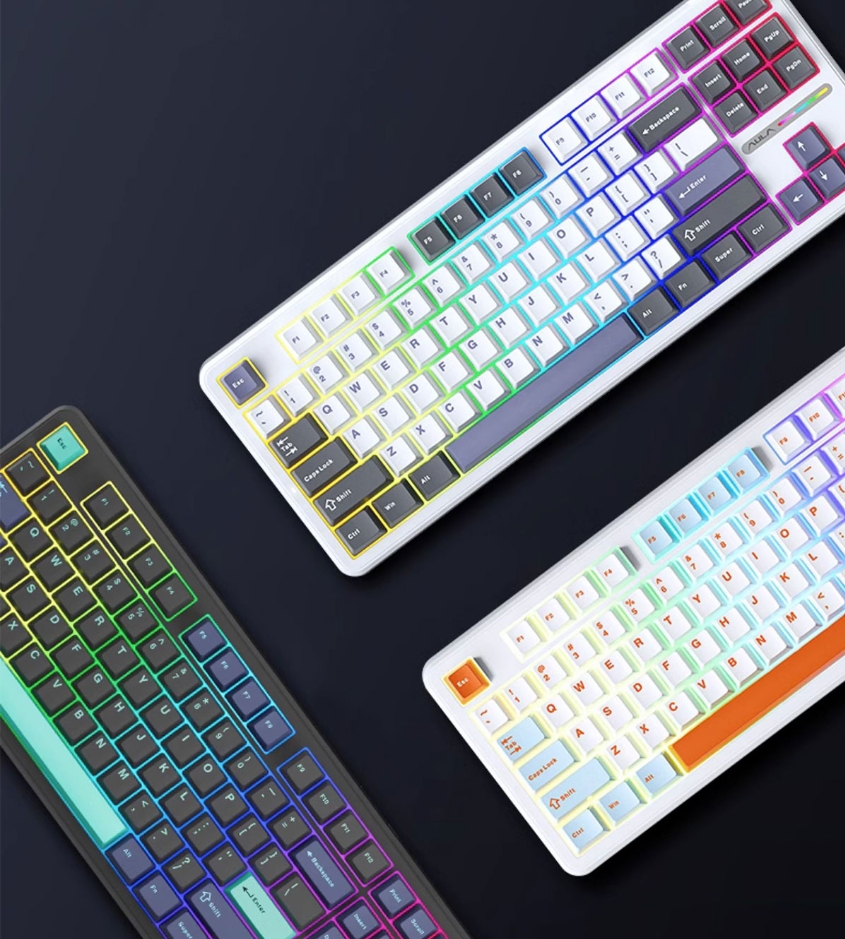Hello everyone, recently many new friends have asked me what kind of keyboard is a mechanical keyboard. Here I have summarized everyone’s questions and will solve them one by one. Now I will explain to you the basic knowledge of mechanical keyboards.
A mechanical keyboard is a type of keyboard where each key has a separate switch (called an "axis") to control the closure. According to the classification of micro switches, mechanical keyboards can be divided into traditional brown switches, blue switches, white switches, black switches, red switches, Romer-G and optical switches. Since each key is composed of an independent micro switch, the key segmentation of a mechanical keyboard is stronger, which provides a special feel for gaming entertainment, and is therefore often regarded as an expensive high-end gaming peripheral.
The axis type and feel of a mechanical keyboard are key factors affecting its performance. Different axis types, such as blue axis, red axis and optical axis, have different trigger pressure, sound and feel. Users can choose the appropriate axis type according to their preferences and needs. In addition, mechanical keyboards also support hot-swap function, which means that users can replace keycaps or axis without restarting the computer, which improves the flexibility and maintainability of the keyboard.
In short, mechanical keyboards have become the first choice for many gamers and professional users due to their excellent performance and personalized customization options.

AULA F87 Gasket Mechanical Keyboard
Mechanical keyboards can be classified from multiple angles. The following are some common classification methods:
1. Axis classification: Mechanical keyboards can be divided into multiple types according to the different axes, such as blue axis, brown axis, red axis, black axis, etc. Each axis has its own unique characteristics and applicable scenarios. For example, the blue axis is loud and suitable for typing; the brown axis is quiet and suitable for gamers; the red axis feels good and is suitable for frequent operations; the black axis has strong force and is suitable for programmers.
2. Key structure classification: The key structure of mechanical keyboards is also different. It can be divided into two types: with T-shaped brackets and without T-shaped brackets. Mechanical keyboards with T-shaped brackets can effectively reduce the jitter of the keys and improve the user experience; keys without T-shaped brackets are more sensitive and have special advantages for some applications that require response speed.
3. Connection method classification: Mechanical keyboard connection methods are also divided into wired connection and wireless connection. Wired mechanical keyboards have faster transmission speeds and no signal loss; wireless mechanical keyboards can bring higher convenience, are not limited by cable length, and can be used anywhere, but there will be certain signal instability.
4. Color classification: Mechanical keyboards can also be classified by color, including black, white, silver, and gray. Keyboards of different colors also differ in design and feel, allowing users to choose the style that suits them.
5. Classification by usage scenario: Mechanical keyboards can also be classified according to usage scenarios, such as gaming mechanical keyboards, office mechanical keyboards, and DIY mechanical keyboards. Gaming mechanical keyboards focus on trigger force and feedback, office mechanical keyboards focus on comfort and durability, and DIY mechanical keyboards allow users to highly customize according to their preferences.

Mechanical keyboard mainly consists of the following parts:
1. Keycaps: Keycaps are the visible part of the keyboard and are responsible for indicating the function of the keys. They are usually made of ABS plastic, POM plastic or PBT plastic, with different colors and material properties.
2. Axis: The axis is the core component of the mechanical keyboard and is responsible for the switching action of the keys. Common axis types include brown axis, blue axis, white axis, black axis, red axis, Romer-G and optical axis, etc. Each axis has its own unique feel.
3. Silicone pads: Silicone pads are usually located under the keycaps to provide additional cushioning and silencing effects to reduce key noise.
4. Top cover: The top cover is the top structure of the keyboard, protecting the internal components from the intrusion of dust and dirt.
5. PCBA: The PCBA (Printed Circuit Board Assembly) is the electronic circuit board of the keyboard, which is responsible for processing key signals and transmitting them to the computer.
6. Positioning plate: The positioning plate is the part of the keyboard responsible for key positioning and stability, ensuring that the keys maintain the correct vertical and horizontal position when pressed.
7. Sandwich pad: The sandwich pad is located between the positioning plate and the bottom cover, providing additional cushioning and noise reduction.
8. Lower cover: The lower cover is the bottom structure of the keyboard, protecting the internal components from damage.

These components work together to enable mechanical keyboards to provide excellent feel and stability. Players can choose different switches, keycap materials and appearance designs according to their preferences and needs to achieve personalized customization.
Contact: AULA
Tel: kalvintsang88
E-mail: kalvin@aulastar.com
add: NO.3 HUAYU STREET,CHANGLONG VILLAGE HUANGJIANG TOWN,DONGGUAN CITY GUANGDONG, CHINA 523710
